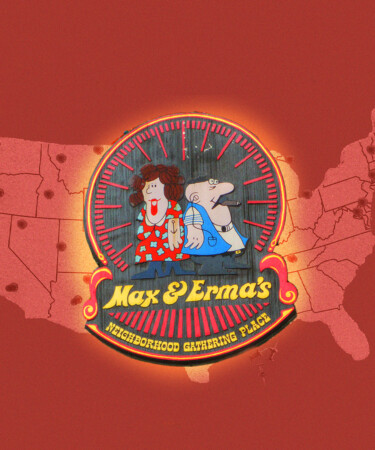If you’ve ever set foot in an Applebee’s, you’re at least moderately acquainted with the controlled chaos of the “everything aesthetic.” Identifiable by its a hodgepodge of knick-knacks, mismatched light fixtures and furniture, vintage antiques, and wall art seemingly chosen at random, this decorative style dominated the early 2000s chain restaurant scene. And while this aesthetic may instantly conjure images of your local T.G.I. Friday’s in its heyday, it was actually popularized by a much smaller regional chain: Max & Erma’s.
The very first Max & Erma’s was opened in 1958 as a standalone bar in the German Village neighborhood of Columbus, Ohio by Max and Erma Visocnik who operated the beloved bar for 14 years before selling to 36-year-old entrepreneur Barry Zacks. In 1972, Zacks then set out to expand the bar’s presence by transforming it into a restaurant targeting the dining market’s mid-priced segment and by building a positive atmosphere by decorating the establishment with quirky decor.
In order to cultivate this feeling of youthful fun, Zacks mounted moosehead trophies, antlers to hold hats, vintage photos, and local sports jerseys on the wood walls and lined up bar stools with human-looking legs. There was even a vintage bathtub that served as a sundae bar. The concept was so successful that by 1982, there were over 10 locations throughout the Midwest, each with a cluttered and quirky aesthetic of its own. Decorations of these restaurants included vintage and neon signs, statues and figurines, and a plethora of artwork. At one location, a 1954 military Jeep hung suspended from the ceiling.
The “everything aesthetic” went beyond just decorations, though. The restaurant’s founder also revamped the Max & Erma’s menu to include enormous portions and introduced the signature “Garbage Burger,” a 10-ounce, meat-and-topping behemoth. At one point in the 1980s, the Max & Erma’s menu spanned over 30 pages and featured everything from burgers to homemade pasta to a raw bar. Zacks, also the CEO of the chain at the time, has even been cited as the proprietor of the salad bar, which is now commonplace at chains like Ruby Tuesday.
However, despite the apparent success of the small chain in local communities, Zack’s extensive menu and gigantic portions proved to be a drain on company resources, and Todd Barnum, Barry Zacks’ business associate, took over as CEO. After shrinking the menu down to just six pages and investing in a $2 million remodeling program to update equipment decor — while remaining true to the random decorative style — Barnum was able to rescue the chain from financial ruin. Under his leadership, revenue increased from $16.5 million in 1986 to $24.3 million in 1989, while net income simultaneously increased from a deficit of $18 million to a high of $1.2 million in the same time period. From 1987 to 1996, Max & Erma’s net earnings increased by almost 400 percent, skyrocketing from $303,000 to $2.2 million. By the early 2000s, there were over 40 locations across Illinois, Indiana, Kentucky, Michigan, North Carolina, Ohio, and Pennsylvania.
And though it was a restaurant first and foremost, the chain took on a reputation as a kitsch museum of sorts. It was even estimated that by the 2000s, Max & Erma’s was spending $40,000 to achieve its restaurant design and even had a dedicated 6,500-square-foot warehouse containing 2,600 barcoded items ready for display at any of the dozens of locations.
Unsurprisingly, it didn’t take long for other chains — both local and national — to catch on to the chain’s eclectic decor. At the same time the Midwestern establishment was expanding further east, restaurants like Applebee’s, T.G.I. Friday’s, and Red Robin had started emulating the decorative style, and Max & Erma’s was no longer able to differentiate itself from its competitors. Instead of finding its decor idiosyncratic, restaurant leadership instead found it to be stuffy and overdone, and sales started taking a hit.
By 2007, exacerbated by the strains of the global financial crisis, Max & Erma’s restaurants were unable to meet the terms of their loans and the establishments nearly shuttered. But in September 2010, the chain was saved from bankruptcy by American Blue Ribbon Holdings (ABRH), which immediately recognized that the chain’s out-of-date interior detracted from the menu that was still favored by consumers. ABRH remodeled a multitude of Max & Erma’s locations, incorporating new brick fireplaces, flatscreen TVs, and draft beer taps among the pulled-back decor to make the interior feel more modern. Despite initial sales boosts following ABRH’s acquisition, Max & Erma’s was still unable to rebound, and in 2016 — following the closure of 19 “underperforming” locations — the chain was sold off to Glacier Restaurant Group. The following year, the original Columbus location closed its doors. Today, only six Max & Erma’s locations remain across Indiana, Michigan, Ohio, and Pennsylvania.
While only a handful of Max & Erma’s still exist, much of the chain’s decor lives on: Most of the now shuttered locations have auctioned off the ornamentations that once decorated their walls. In 2016, when Cincinnati’s Rookwood Commons location closed its doors, the team auctioned off items like a foam hamburger slice the size of a small booth, traffic lights, a fire department pedal car, neon signs, and a vintage Sears & Roebuck cruiser bike. The aforementioned military Jeep was auctioned off when the Maumee, Ohio, location was closed in 2021. And when Pennsylvania’s Cranberry Township location closed earlier this year, it sold off a 12-foot-long boat that was previously hung from the ceiling.
Who knows? Perhaps some of that recycled kitsch will find its way into your local Applebee’s.
